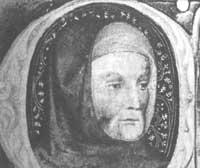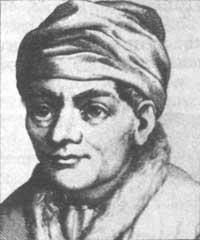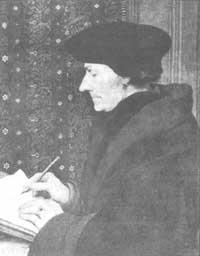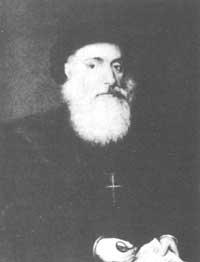At the gates of the Renaissance
The black plague brought with it economic and social confusion and the Hundred Years War, which did not offer too many possibilities for the environment to be calm for study. However, the world was constantly changing.

In a previous work we have seen the cracks that opened in the wall of the Scholastica some lord of Duns Scoto and William of Ockham; the flight of William of Ockham from the prison of the Pope and the sponsorship of the Ludwig of Bavaria suppose a revolution against the monolithic power of the Church and the claim of rights against the universal authority of the Church.
The spirit of the Renaissance appears for the first time in Italy. At that time Italy was rising from the destruction suffered in the previous era. Perhaps surrounded by remains of Roman architecture, it facilitated the way to love the classics. On the other hand, the state cities of Quattrocento, in addition to being the starting point of modern states of today, constituted an ideal meeting point for science and culture.
To understand the advantage on this point of Italy, XIII. Knowing the opinion of the 19th century Franciscan Salimbene de Parma will not be useless: In the kingdoms outside Italy, in the cities only simple people live, the knights and ladies of the nobility live in their feudal ivory towers, that is, in their agricultural palaces to take over the lands. In Italy, on the other hand, high-level people live in cities, where they spend most of their time. Undoubtedly, the presence of the owners improves the performance of the farms, but by the way, and in a time of complicated communications, the intellectual relations necessary for the culture in the life of the hamlet are not easy to create. On the contrary, the urban life of the great people of northern Italy offered an atmosphere conducive to it, giving rise to the Renaissance.
The Renaissance was not just a literary revolution. Although the literary element is one of the first and foremost in time, other elements must be taken into account. The forerunner of this revolution is Petrarch—1304-1374. In it you can see another spirit very far from the medieval scholastic hidden in the poems of Dante. Petrarch is the first cultural man to be a supporter of good Latin by rejecting the Latin evil used by scholastics. Along with this, he is committed to the recovery of the true spirit of classical thought and the freedom of reason it entails.

Petrarch was mistaken for a century, but since the beginning of the following century, the XV, a special interest in classical literature was revealed. Therefore, many Greeks came from east to west to teach ancient Greek literature and culture. The assimilation of Constinopolis by the Turk in 1453 gave a great impetus to this process. This caused many good teachers to come to the West who accompanied their books and their writing. The search for manuscripts became fashionable.
In the libraries of the Italian monasteries and of all Europe numerous catches and robberies were made, and the men of commerce with representatives in the east made five to bring Greek writings that did not reach the west. Thus, eight or nine centuries later, Western cultural men had the opportunity and passion to know the science and philosophy of the ancient Greeks.
But the most important thing that this knowledge was the spirit of freedom of investigation that he brought and the desire to analyze all the issues, that is, the environment that caused humanism. Despite following the tendencies given by authoritarian religion and therefore being willing to accept what the authorities said on other issues, humanists broke the path of rebirth that later would know science. It is incredible that men of scientific thought, without humanism, break the advances set by theology.
Humanism passed from northern Italy. One of the first in this past is Johann Müller — 1436 -1476. This was born in the city of Königsberg and was therefore called Regiomontanus. It is up to him for the first time to combine science and humanism. He translated works by Ptolemy and other Greek writers into Latin and in 1471 he built an observatory in Nürenberg in which he produced a clock of weight and several astronomical instruments.

However, the main consequence of the Renaissance in Germany, due to biblical research, is the Reformation. Germany had other interests and a new cultural impulse, but did not conquer the pagan fondness and delicacy of Italian culture. France was more compatible with the Italian spirit than Germany, where it developed a more humanistic movement.
In the Northern Renaissance, the most prestigious is the Desiderio Erasmo of Rotterdam (1467 1536). Erasma saw in humanism the influence of knowledge of the cleanliness of the gaps of his time: the lack of wisdom of monasteries, the excesses of the Church, the pride of scholastics and the low degree of morality, among others. While scholastic theologians used texts extracted from her and here according to her wishes, Erasma wanted to show everything that the Bible, as a whole, and the Church Fathers want to teach and say.
During a season and especially with Pope Leo X, 1513-1521, the Vatican itself became the cabin of ancient culture. But, after the Gudaris of the Empire stepped on Rome in 1527, that new world turned upside down and the Pope put an end to the previous generous policy, fighting hard against what he did not understand or control and hindering the march of modern culture.
Paper was invented in China in the first century of our era. It is believed that the inventor was Tsai Lun. However, in Europe, the paper industries from the last crusade began. About a century later and with the invention of the liberated types, printing was carried out through the fixed molds, so the end of the boring manuscript system on parchment began.
At the same time, despite the low level of navigation, the geographical findings knew a huge success and thrust. The first explorers were the Portuguese. They used Arab-Jewish astronomy. The Basque Range was the first to arrive in India surrounding the End of Good Hope in 1497. At that time the Greek theory of Earth's roundness was approved. According to this theory, going west along the Atlantic would have to reach the Asian coast, so there was a maritime way to bring things from India to Europe.

This idea can also be seen in the Greeks, as in Posidonioga. After a thousand failed attempts came the time of success: On October 12, 1492, Kristobal Colombe discovered the American coast. Twenty years later, and after three years of travel, a Basque man, Juan Sebastián Elcano, went round the Earth, demonstrating without lips the roundness of our planet.
The immediate consequence of these great journeys is, together with the discovery of new lands, the expansion and openness of thought. But it wasn't just that. With the expansion of trade to new lands, Western industries knew the momentum. This impulse was carried out in two ways. On the one hand, the direct and indirect economic impact of new markets and supply sources. On the other hand, this process is due to the monetary factor.
Currency is not in itself wealth, but symbol, a way of exchange. The gold and silver of the New World caused the proliferation of the currency, so prices increased. Through this increase the profits of both the producer and the trader increased. The richness and tranquility it entails, helped the environment necessary for the burulan and the cultural environment became much wider than the medieval.
Buletina
Bidali zure helbide elektronikoa eta jaso asteroko buletina zure sarrera-ontzian











